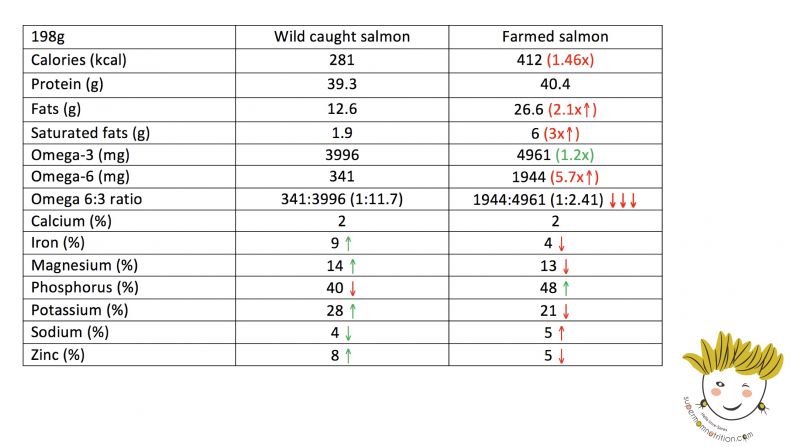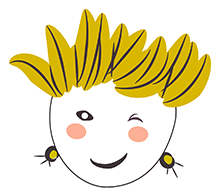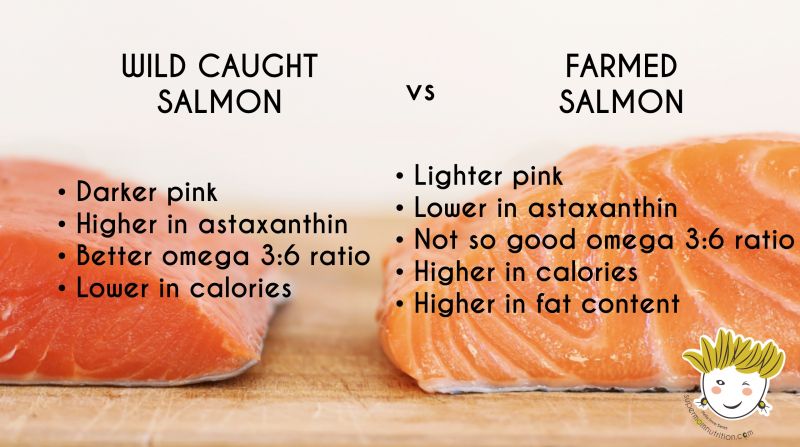Look at the colour on the picture. The wild caught salmon has a dark pink colour and farmed salmon has a lighter pink colour.
The colour of the salmon, just like in case of flamingos, comes mostly from the food they eat. While the wild salmon eats all natural foods they can find in the waters like planktons, smaller fish, shrimps, krill. Farmed salmons eat processed foods made out of poultry meal and fat, soy, wheat, corn, rapeseed oil. Since farmed salmons don’t eat what they should, they can’t have the same dark pink colour. In some fish feed the farms try to put synthetic astaxanthin, but obviously it doesn’t have the same effect. Natural astaxanthin, that wild salmons can eat through their diet provides their darker pink colour.
Astaxanthin is a strong antioxidant. The level of astaxanthin can be very different in wild caught and farmed salmons. This level can vary the type of salmon as well. And it means, it has a different effect on the human body.
Look at the picture! You can see that farmed salmon has wider whitish stripes. That shows how much more it’s fat content is. That means, that the same portion of farmed salmon is higher on fat content and calorie content.
Before you think I’m freaked out of fat: no, I’m not. We need to consume fat to be healthy. There are 2 questions here: quantity and quality.
We should aim for a 1:1 to 5:1 ratio of omega 6 and 3. 1:1 means, that with every omega 6 portion we should consume the same amount of omega 3. In case of 5:1 ratio we can eat 5 portions of omega 6 and 1 portion of omega 3 fats.
In some articles you can read, that farmed salmon has higher omega 3 content, than wild one. This would be great! But … Before it confuses you, you have to be aware that it’s because farmed salmon is much higher on fat in general. While farmed salmon has less than 1.5 times more omega 3 than the wild one, the farmed one has nearly 6 times higher omega 6 content than the wild one. And the ratio is very important.
Omega 3 is more anti-inflammatory (reducing inflammation), while omega 6 is more pro-inflammatory (causing inflammation).
If someone has a health problem, then it’s better to get closer to the 1:1 ratio.
Western diets tend to be very heavy on omega 6 fatty acids, the ratio can easily be 15:1 – 20:1.
Salmon has an interesting feature. It’s higher on omega 3 than on omega 6. It’s a rare find in this world. But while in case of wild caught salmon there’s nearly 12 times more omega 3 than omega 6, it’s very different for farmed salmon. In farmed salmon there’s only 2.4 times more omega 3 compared to omega 6. That’s a huge difference.
If you check this table, you can compare an average wild caught salmon’s values with a farmed one. If you look at other values too, not just the omega 6:3 ratio, you can see, that the whole nutritional profile is different, as if we talk about a different species. The details are coming from nutritiondata.self.com.

Probably the numbers are different, but this sort of nutritional profile difference is similar in case of wild animals and farmed animal.
And I haven’t mentioned the hormones, antibiotics and PCBs beside other things, that make a huge difference between wild and farmed animals and how fish farming can affect the environment.
Picture is from: http://oecfood.net/wild-farmed-kinds-salmon-choose/
References
https://www.blm.gov/or/resources/recreation/mcgregor/files/what_salmon_eat.pdf
https://www.wildsalmoncenter.org/2016/05/24/what-salmon-should-i-eat/
https://www.doh.wa.gov/CommunityandEnvironment/Food/Fish/FarmedSalmon
http://www.farmedanddangerous.org/salmon-farming-problems/environmental-impacts/fish-feed/
https://articles.mercola.com/sites/articles/archive/2013/04/15/wild-alaskan-salmon.aspx
https://www.ncbi.nlm.nih.gov/pmc/articles/PMC3917265/
https://www.ncbi.nlm.nih.gov/pubmed/12442909
https://www.ncbi.nlm.nih.gov/pmc/articles/PMC4808858/
https://www.ncbi.nlm.nih.gov/pmc/articles/PMC3335257/
http://nutritiondata.self.com/facts/finfish-and-shellfish-products/4258/2
http://nutritiondata.self.com/facts/finfish-and-shellfish-products/4102/2







